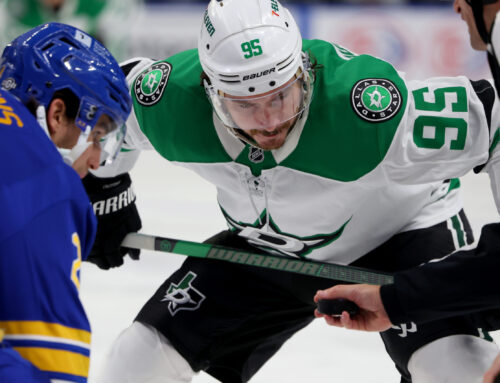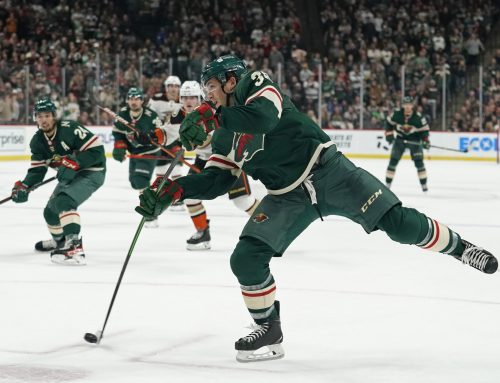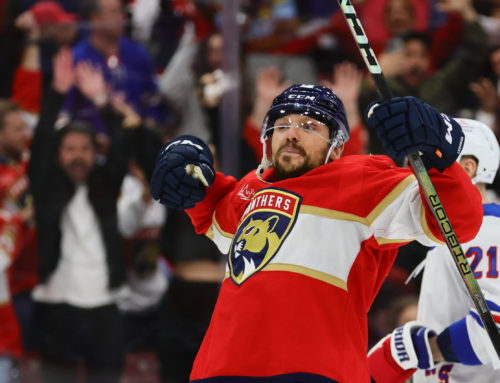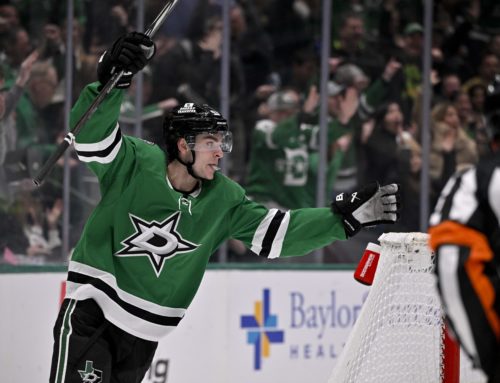
Not Bad Chad, Wild, Sharks, analytics and fantasy hockey
There’s lots of discussion right now as to whether Chad Johnson is a legitimate starting goalie. Yet there he was on Friday night, stopping 21 of 23 shots in earning the Flames a shootout victory. Over the past month, only one goalie (Sergei Bobrovsky) has earned more wins that Johnson, while four other goalies have earned the same number. Clearly he is in the driver’s seat between the pipes in Cowtown.
It might be that Johnson is a good goalie that simply needed an opportunity, and his career 2.35 goals-against average and .918 save percentage would indicate that he’s not a massive dropoff from other goalies. Here’s another stat that might validate Johnson's case: As strong as Brian Elliott was during his time with the Blues, he never played 50 games in any one season in St. Louis. In fact, the only season where he exceeded 50 games was 2009-10 when he played 55 games for Ottawa.
Elliott, who has lost six consecutive games, will start to play better. I’m going to meet halfway on the argument for either goalie and say that this will evolve into a timeshare by season’s end.
#Flames Chad Johnson has been one of the NHL's best goalies over the past month pic.twitter.com/xLhNEYr8WL
— Sportsnet Stats (@SNstats) December 3, 2016
*
I love it when I pick a player for the Sportsnet waiver wire report and he scores a goal in his next game. Tonight that player was Mikko Koivu. Six points in six games for the normally consistent younger Koivu brother.
Only one player recorded more than a point in the Flames/Wild game, and that was Jared Spurgeon. He has points in back-to-back games after going without a point in his last four games. Spurgeon is a +11 this season, which trails only Ryan Suter and Jason Zucker on the Wild.
More interesting than that: The Wild have only three minus players (Zach Parise, Zack Mitchell, Marco Scandella). With that in mind, it shouldn’t come as much of a surprise that the Wild have the top goal differential in the Western Conference (+14). Devan Dubnyk’s goaltending has a lot to do with it, but the usually defensively-minded Wild are 11th in the NHL at 2.78 goals per game. Combine that with a 2.09 team goals-against average (2nd in the NHL), it’s a surprise that the Wild are not truly a .500 team (I’m old school and don’t really consider 11-8-4 to be a .500 record).
*
We’re barely into December and Brent Burns already has ten goals. That should put him pace for over 30 goals. You’d have to go all the way back to the 2008-09 season for the last time a defenseman scored 30 goals, when Mike Green scored 31 (QuantHockey). Burns also gave you eight shots on goal on Friday to up his league-leading total to 107 – the only player to reach 100 shots this season. A defenseman is keeping me afloat in goals and shots on goal while Steven Stamkos is injured. Go figure.
After a slow start, Martin Jones has picked it up lately. He’s won five of his past six starts.
Martin Jones is 8-2-1 in his last 11 starts, with a 1.46 GAA and a .945 save pct. In his first 11, he was 5-6-0, 2.56 GAA, .900 save pct.
— Darin Stephens (@SharksStats) December 3, 2016
Joe Thornton recorded two helpers for the Sharks in this game after being held without a point in his previous five games. He’s had even less success in the goal department, as he has not found the back of the net since November 8 – a span of 12 games. With 15 points in 25 games, Big Joe is currently on pace for just 50 points. Surely you did not think he could replicate last season, but 30 points is a massive dropoff. Especially with Joe Pavelski by his side.
I’ve been chomping at the bit to say something about Mikkel Boedker, since I own him in my deep keeper league. He was held off the scoresheet again on Friday, but he had recorded points in his previous two games. With just four points in 25 games, Boedker should be on the drop pile in most leagues. His 8.3 percent shooting accuracy suggests that a modest improvement is on the way. But his power-play usage has declined down to near or under a minute in each of his last six games. With the Sharks being so deep up front, Boedker made the wrong choice of teams as far as his fantasy value goes.
*
To help prep you for the weekend, here are Saturday’s confirmed starting goalies at the time of this writing, via Goalie Post:
Robin Lehner – returning from injury
Corey Crawford – first of back-to-backs, so Scott Darling could start Sunday
Carter Hutton – only 5 percent owned in Yahoo leagues, a somewhat risky spot start but could be worth considering if you need wins
Ryan Miller – if goalie penalty minutes count in your league, he faces the Leafs for the first time since their fight-filled affair several weeks ago
*
With the lack of games on a Friday night, it’s time for another editorial comment. Last Sunday night I wrote the fantasy take article on Gerard Gallant’s firing from the Florida Panthers. This firing turned out to be one of the more heavily debated coaching moves that I’ve seen in a while, since the line between the analytics crowd and the mainstream media was clearly drawn.
I’ll admit that I’m kind of on the fence when it comes to “fancy stats.” Those who know me well say that I’m a numbers guy. Math was (mostly) easy for me through school (until I was hit with calculus, which still doesn’t make any sense to me, even though I’m a lot smarter now than I was when I was 18). But I’ve also played and watched the game a lot, and as I told someone that I was discussing this firing with, hockey games are won and lost on the ice and not by entering an algorithm into a computer. On the other hand, analytics can draw some insight that the naked eye cannot.
I don’t use analytics much in my writing simply because there are enough other numbers and observations that can track a player’s projected performance. Years of playing and watching hockey (and sports in general) have taught me that a game with many talented individuals often turns out to be a series of random events. But over the long term, trends and patterns emerge. Like anyone who works in any science will tell you, sample size matters. But the fallacy that I’ve seen at least a few analytics believers fall into is that fancy stats will always save the day. Not true.
But I digress. This is a fantasy hockey website, so I’m going to give my take on the usefulness of a few popular advanced stats to fantasy hockey.
Zone-Start/Finish Percentage (OZS%, OZF%) – very useful
This stat doesn’t receive as much attention as the others, but it tracks how often a player starts or finishes a shift in the offensive zone. For instance, a player may receive lots of icetime. But if the player spends over half that time in the defensive zones, often because the coach wants a center to win a faceoff in his own zone, then it minimizes his scoring chances. Of course, it’s also important that a player can push his way into the offensive zone and not vice-versa. So it’s a great supplement to time on ice. Some players can eat up a lot of icetime, but ultimately scoring talent and situation will drive production.
PDO – somewhat useful
Part of PDO is shooting percentage, which is often used to measure “luck.” A player’s season-long shooting percentage is compared to his career percentage. If the player’s season shooting percentage is around 20% but career shooting percentage is around 10%, and the player has been scoring at a higher pace than normal, then that pace is expected to slow down (but not reverse itself to the point that the player hits a wall necessarily). Likewise, it can be used to identify whether a slumping player will eventually recover. PDO also includes team save percentage, which skaters themselves have little control over, unless average shot distance against (another advanced stat) because of shot blocking and other defensive schemes is high. So although PDO is useful, I prefer looking at shooting percentage by itself.
Corsi/Fenwick – somewhat useful, but may be misleading
I’ll lump these two together, even though there are specific camps that identify only as one and not the other. I’m okay with using only the “offense per 60 minutes” part, which can help identify a player who deserves additional icetime. But it’s the 5-on-5 part that gets me. Sure, it also helps identify strong players, but these two stats seem more geared toward identifying teams that have been lucky or not lucky than that of players.
If you play in a pure points league, you can probably disregard my next argument as to why Corsi and Fenwick are misleading. Otherwise, hear me out. As someone who plays in roto and head-to-head leagues that count power-play points, I don’t care about 5-on-5 play on its own. I wrote about this last year for Today’s Slapshot, but I consider power-play points to be fantasy hockey’s version of the double word score in Scrabble. To maximize multiple categories, give me power-play producers. A goal, an assist, and a shot on goal all have the potential to be created from a power-play point.
In this case, knowledge is power. But sometimes the less you know the better.
On the other hand, Corsi and Fenwick can be considered when evaluating a particular goalie’s opponent, the same way as the strength of the team’s offense can. More shot attempts and chances can lead to more goals.
Enjoy your Saturday. Follow me on Twitter @Ian_Gooding.
7 Comments
Leave A Comment
You must be logged in to post a comment.





 SEA
SEA CHI
CHI OTT
OTT EDM
EDM DAL
DAL STL
STL FLA
FLA CBJ
CBJ L.A
L.A ANA
ANA MTL
MTL

Regarding Thornton. We should just chill about the 30 point drop off. Look back to last season. Thornton through games to end of November, 23 games, he had 15 points. Guess what, after 25 games this year, that’s right, 15 points. And we know how last season ended up. Now 82 is a stretch, but 70’s I think is not out of the question
Great point. He should outscore 50, particularly if he stays on Pavelski’s line. 70 won’t be easy though.
Great Ramblings. Love the bigger picture thoughts and the starting goalie posts saved me a little time.
Thanks! Glad it helped.
Excellent Scrabble analogy. Well put
Signed: big scrabble fan!
Great discussion on the advanced stats, Ian. I’m very much enjoying the fancy stats revolution in hockey but it pains me to see how poorly it is understood by many sports writers. My biggest pet peeve is when a player’s CF% is presented without context. Saying “Player X has a 52% CF” sounds impressive but is meaningless. If Player X plays on a strong team a 52% CF could actually be below average, and Player X may be crap. Similarly, if Player X is starting 70% of his shifts in the OZ then a CF of 52% is actually not a great stat. Context, context, context.
I also don’t know why PDO is quoted so often, especially in fantasy articles. As you mentioned, only the on-ice Sh% component of PDO really matters if we are talking about statistical regression of forwards and defencemen, so why not quote this number instead of PDO?
Anyone know of a good site that still publishes Player Usage Charts? These are great for putting Corsi values into context. I only know of corsica.hockey for 2016/17 usage charts but the site is a bit unstable for me.
Big Joe is Joe Pavelski… As in The Big Pavelski… Joe Thornton is Jumbo Joe